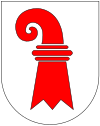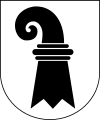Flag and coat of arms of the canton of Basel-Landschaft
The coat of arms of the half-canton of Basel-Landschaft is a red crook pointing to the right ( heraldic : left) on a white (heraldic: silver) field, called the Baselstab . Three crossbars interrupt this rod, which contains seven so-called crabs (points) at the top, widens towards the bottom and ends in three spikes. The symbol of the Basel staff is the curved pastoral staff of the bishops. Shield holders are lions, wild men , angels and, since the 15th century, basilisks - dragons with a cock's head and snake tail. The oldest known representation of a bishop's staff can be found on coins that were minted in the 11th century; the current form of the staff has been used since the 13th century. The coat of arms corresponds to the civil coat of arms of the city of Liestal , reduced by the red edge of the shield , has existed in its current form since 1834 and has been official since 1947. The stand colors are white and red.
Blazon
The official blazon of the coat of arms of the canton of Basel-Landschaft reads:
In silver, a red bishop's staff turned to the left (Basel staff) with seven red crabs (Gothic decorations) on the pommel.
history


Origins
The coat of arms appeared for the first time between 1072 and 1133, at that time still in the form of a wooden stick, which ended in gold at the top. In the 12th century, the staff appeared in its current form, the symbol was quickly assigned to the diocese of Basel and the city as a state entity, which was the center of the diocese at that time. The first mention of the coat of arms of the bishops of Basel comes from 1384, at that time with two coats of arms on the left and right of the bishop's staff. The bishop's staff can also be seen in seals from this period.
When the canton of Basel-Landschaft was separated from the city in 1832, people had to think about a new coat of arms. In 1834 the coat of arms of the city of Liestal was adopted as the cantonal coat of arms, but without the thick red border (shield edge). To avoid confusion, the city of Liestal changed its city coat of arms in 1921, in which it omitted the border in accordance with its city seal and kept the lower half of the coat of arms completely in red. The canton's coat of arms has not been changed since 1834 and was officially recognized in 1947. The origin of the crabs is unclear, the number of crabs on the Liestal coat of arms has changed over the centuries (but not after 1834).
Differences to the coat of arms of the canton of Basel-Stadt
Before 1385 the red crosier stood for both the city and the diocese of Basel. Around 1385, the city of Basel gained a higher degree of independence from the bishop, with its own jurisdiction. In the early 15th century, in contrast to the coat of arms of the Principality of Basel, which showed the bishop's staff in red on a silver background, the coat of arms of the city of Basel was created, identical to the coat of arms of today's half-canton Basel-Stadt . After the Reformation, the city and the diocese finally separated. The areas ruled by the city were reformed. After the prince-bishopric fell in 1792, the episcopal coat of arms was no longer used.
When the two Basel cantons separated in 1832, the coat of arms of the city of Liestal served as a model for the coat of arms of the canton of Basel-Landschaft.
The different sign holders
The shield holders also date from the early 14th century, at first angels were popular as figures, then, at the end of the 15th century, they were first replaced by lions and then by basilisks. Only in the 19th century did the basilisk disappear again as a shield holder. Later the Wilde Mann was partly used as a shield holder.
Trivia
The dialect expression Siebedupf, which is used for the Basel landscape variant of the Basel staff and, in a broader sense, to invoke Basel landscape identity in general, is likely to be more recent, as is the circular version of the coat of arms created by the Liestal painter and graphic artist Otto Plattner (1886–1951) balls removed from the rod instead of the original crabs.
literature
- Joseph Melchior Galliker: The crabs at the “Siebedupf” in Basel Land. In: Swiss coats of arms and flags. Issue 7, 2004, pp. 68-69.
- Urs Häusel, Jeannette Brêchet: Siebedupf. Basellandschaftliche Gebäudeversicherung, Liestal 2000.
- Louis Mühlemann: coat of arms and flags of Switzerland. 3. Edition. Bühler-Verlag, Lengnau 1991, ISBN 3-9520071-1-0 .
Individual evidence
- ^ Louis Mühlemann: Coats of arms and flags of Switzerland. Bühler-Verlag, Lengnau, p. 89.
- ↑ a b Canton of Basel-Stadt in the Official Wappenlexikon
- ↑ History of the Liestal coat of arms ( Memento of the original from December 1, 2008 in the Internet Archive ) Info: The archive link was inserted automatically and has not yet been checked. Please check the original and archive link according to the instructions and then remove this notice.
- ^ Louis Mühlemann: Coats of arms and flags of Switzerland , Bühler Verlag, Lengnau, 1977, 1997.

